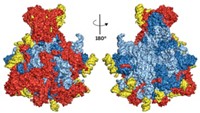Advertisement
Grab your lab coat. Let's get started
Welcome!
Welcome!
Create an account below to get 6 C&EN articles per month, receive newsletters and more - all free.
It seems this is your first time logging in online. Please enter the following information to continue.
As an ACS member you automatically get access to this site. All we need is few more details to create your reading experience.
Not you? Sign in with a different account.
Not you? Sign in with a different account.
ERROR 1
ERROR 1
ERROR 2
ERROR 2
ERROR 2
ERROR 2
ERROR 2
Password and Confirm password must match.
If you have an ACS member number, please enter it here so we can link this account to your membership. (optional)
ERROR 2
ACS values your privacy. By submitting your information, you are gaining access to C&EN and subscribing to our weekly newsletter. We use the information you provide to make your reading experience better, and we will never sell your data to third party members.
Analytical Chemistry
NMR Structures Of Larger Proteins
Isotope labeling of amino acids leads to simpler, less congested NMR spectra
by Stu Borman
March 1, 2006
| A version of this story appeared in
Volume 84, Issue 10

Protein properties and interactions are often studied through nuclear magnetic resonance (NMR) spectrometry, which can provide 3-D solution structures of proteins. But it's currently difficult to elucidate NMR structures of large proteins because their spectra are too complex. At present, fewer than 2% of all NMR structures in the Protein Data Bank have masses exceeding 25 kDa, whereas many proteins weigh in at hundreds of kilodaltons.
Stereo-array isotope labeling (SAIL) could now ameliorate this problem. Chemistry professor Masatsune Kainosho of Tokyo Metropolitan University (TMU) and coworkers, with support from the Japan Science & Technology Agency, developed the technique and report its use to determine the structure of a 41-kDa protein (Nature 2006, 440, 52).

In SAIL, chiral organic synthesis is used to prepare amino acids labeled with deuterium, carbon-13, and nitrogen-15 in a highly stereo- and regiospecific manner, and a protein is then synthesized from the labeled amino acids. The NMR spectrum of the resulting SAIL protein is simpler, less congested, and more easily interpretable than that of the corresponding conventional protein. Kainosho and coworkers believe the approach should make it possible to routinely solve the structures of proteins at least twice as large as those commonly determined today by NMR.
Drawbacks are that the labeled amino acids are difficult to synthesize and must be incorporated into proteins by in vitro cell-free protein synthesis, which is not easy to carry out. But a TMU-based venture company, with Japanese government support, is being set up to supply SAIL amino acids commercially. Kainosho and coworkers are also trying to fully automate SAIL-based structure determination and to push the technique's molecular-weight limits ever higher.

SAIL is "a triumph and the achievement of a lifetime," comments Kurt Wüthrich, a professor of molecular biology and biophysics at the Swiss Federal Institute of Technology, Zurich, who shared the 2002 Nobel Prize in Chemistry for work on NMR structure analysis. "It's difficult to estimate just how far it could go, but it could really ring in a new era" in protein NMR. In addition to permitting larger proteins to be analyzed, SAIL could also enable some NMR experiments that aren't practical currently, assuming "SAIL amino acids become widely available at an affordable price," Wüthrich notes.
With the same proviso, SAIL "is going to have major impact on structural protein NMR studies," says Ad Bax, section chief of the National Institute of Diabetes & Digestive & Kidney Diseases, Bethesda, Md.
It's "an extremely important and long-sought advance," according to professor of molecular biology Peter E. Wright of Scripps Research Institute, La Jolla, Calif. "It's a real tour de force and a major breakthrough. The degree of spectral simplification and the reduction in line width and resonance overlap that can be achieved by SAIL labeling is very impressive and promises to revolutionize NMR structure determination for large proteins of 40 kDa and above."
Biochemistry professor John L. Markley of the University of Wisconsin, Madison, a collaborator of Kainosho's, adds that SAIL "represents the culmination of over 10 years of hard work by Kainosho and coworkers" and "has much forward potential" for applications such as large-protein analysis, solid-state NMR, and "answering very specific questions about protein structure and dynamics."




Join the conversation
Contact the reporter
Submit a Letter to the Editor for publication
Engage with us on Twitter